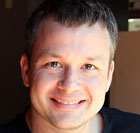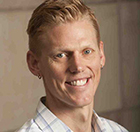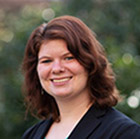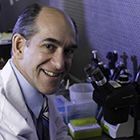
Reactions from SfN 2019
Spectrum heads to Chicago to cover the 2019 Society for Neuroscience meeting.
23 October 2019: Day Five

Assistant professor, Geisinger Health System
Face recognition: Jason Griffin, a graduate student in Suzy Scherf’s lab at Penn State University, presented results on face recognition in people with autism. The team did a meta-analysis of 94 unique studies from the past 40 years involving more than 4,500 participants. The analysis revealed that autistic people do have more trouble with face recognition than typical people do. When the researchers controlled for factors such as age, intelligence and sex, the results remained the same. The findings suggest that subtle problems with face recognition may contribute to social communication difficulties in autism, even though they are not part of the condition’s diagnostic criteria.

Associate professor, Washington University in St. Louis
Super models: At SfN, I was impressed with the strong work describing new models of recently discovered autism genes, such as a poster on a mouse model of POGZ gene mutations presented by Kensuke Matsumura, a member of Yasuhiro Nakazawa’s lab at the University of Osaka, Japan. Models like this one are useful tools for understanding the role of these genes in brain development and the function of neural circuits.
I also really liked a poster presentation of an experiment by Jenna Levy, a graduate student at the Scripps Institute in Jupiter, Florida. Levy reported using mouse models to test the interaction of two autism genes, DYRK1A and PTEN.
But I still saw erroneous within-group-only comparisons in some of the behavioral experiments described in posters. We published a study this summer showing why such comparisons are misleading, but, in case you missed it, the upshot is this: If you are drawing conclusions about differences between two groups, your statistics need to compare across those two groups. Perhaps by next year’s SfN, we will have rooted out within-group-only comparisons.
22 October 2019: Day Four
Associate professor, Washington University in St. Louis
Lessons from other fields: This afternoon Li-Huei Tsai, a neuroscientist at Massachusetts Institute of Technology, gave a phenomenal lecture in which she gave an example of a basic science discovery leading to a clinical trial. Though the talk focused on Alzheimer’s disease, it demonstrated the potential ease and power of therapies based on modulating brain waves.
What is most phenomenal is how fast the therapy went to a clinical trial. In December 2016, Tsai’s team published a study establishing that enhancing a 40-hertz brain rhythm diminished in Alzheimer’s could dramatically reduce Alzheimer’s pathology. Initial work used genetic tricks to enhance this 40-hertz activity in a mouse model of Alzheimer’s. Tsai’s team realized it was feasible to boost the frequency using flickering lights and tones.
Cut to three years and several elegant papers later: The team is testing this noninvasive therapy in people with Alzheimer’s. The story shows that, sometimes, the right insight in the right hands can quickly lead to a potentially game-changing therapy. It reminds us all to be on the lookout for that new way of thinking about what we study, whether it is Alzheimer’s or autism.
Assistant professor, Geisinger Health System
Knockout presentation: Today’s poster session featured a presentation by Sarah Ferri, a postdoctoral fellow working with Ted Abel at University of Iowa. She presented work on a mouse model of autism in which the protocadherin 10 gene is deleted. This gene codes for a cell adhesion molecule involved in dendritic spine development. The data showed that deleting the gene in the basolateral amygdala of adult mice causes social deficits and increased fear memory. Remarkably, this effect shows up only in male mice. Deleting the gene also seems to cause dysregulation of estrogen receptor expression in the cerebellum.
This work shows that the same genetic change can lead to sex-dependent differences in behavior, perhaps helping us to understand why autism is four times as common in males as in females.
Professor, University of Missouri
Valuable models: Today featured a series of interesting talks about induced pluripotent stem cells derived from people with autism. Mike Nestor’s team at the Hussman Institute for Autism reported using these models to study the biology underlying autism’s heterogeneity, and Sundari Chetty of Stanford University discussed using similar cell models to study brain overgrowth in autism. These models allow scientists to study how autism genetics influences autism traits.
State pride: I would also like to highlight two studies from my state of origin, Indiana. Dan Kennedy at Indiana University is studying the reasons for the variability in functional connectivity studies in autism. This has been a vexing issue for researchers. Also, Brandon Keehn at Purdue University presented on the relationship between attention and pupil diameter as a marker of activity of the locus coeruleus, the point of origin of noradrenergic neurons, in people with autism. I think the role of the noradrenergic system in autism will receive increasing attention in the coming years.

Postdoctoral fellow, Icahn School of Medicine at Mount Sinai
Marvelous microexons: The work presented by Thomas Gonatopoulos-Pourtnatzis, a postdoctoral fellow at University of Toronto, was fascinating. He highlighted the role of microexons in genes controlling higher-order cognitive functions. He started his presentation by reminding us that these very small exons are frequently disrupted in autism.
In a previous study, he used a novel CRISPR-based screening strategy to discover that the gene SRRM4 regulates the splicing of microexons in neurons. Then he engineered mice lacking one copy of SRRM4 and observed autistic traits, including altered behavior and synaptic transmission. SRRM4 controls the microexon EIF4G, a crucial protein for mRNA translation. So he generated stem cells lacking the EIF4G microexon. These cells show an increase in translation. In parallel, he generated a mouse model lacking the EIF4G microexon and found it had deficits in learning and memory.
These results are intriguing, but whether these differences in microexons are a cause or consequence of autism remains a mystery.
21 October 2019: Day Three

Assistant professor, Geisinger Health System
Vision in focus: Jesse Gomez, a postdoctoral fellow in Kevin Weiner’s lab at the University of California, Berkeley, presented work aimed at understanding the genetic underpinnings of the structure of the visual cortex. Using an Allen Institute brain atlas, he found that the top 1 percent of genes expressed in the visual cortex are clustered, revealing a positive and negative gradient from the early visual cortex to fusiform (face-detecting) areas of the brain.
Mutations in some of the genes, including CCN1, are linked to conditions such as Turner syndrome and retinitis pigmentosa that affect the visual system. The researchers also linked the expression of certain genes to higher tissue density in an area of the retina. One of the most interesting findings was that the expression patterns of the genes in these clusters in children do not resemble those of adults until about age 5.
Although this work was done in brain tissue and maps from typical people, it may inform how gene expression differences relate to atypical visual processing in people with autism.

Assistant professor, University of California, Davis
Terrific tools: Two sessions provided an exciting picture of the cellular makeup of the brain. A morning session showcased our growing understanding of which cells are present in the human brain and how these cells differ in epigenetic and transcriptional identity across evolution, from mice to humans. For example, Fenna Krienen, a postdoctoral fellow in the McCarroll Lab at Harvard Medical School, highlighted interneuron cell types that are uniquely human in terms of what they are and where they are in the brain. The emerging maps of cell identity represent an important step in our understanding of the makeup of the brain. They are likely to be a transformative resource for the community, including those of us trying to understand how specific autism genes affect the development and function of brain cells and circuits.
In the afternoon, I was impressed by presentations on organoid models of the brain. For example, Gray Camp, at the Institute of Molecular and Clinical Ophthalmology Basel, presented on evolutionary differences between humans and nonhuman primates in brain development. Sergiu Pasca discussed how organoids can be used to model brain pathology from mutations (CACNA1C and Timothy syndrome) and environment (hypoxia, preterm birth). These presentations highlighted the fast-moving gains in understanding of brain development, evolution and disease in ways not possible without powerful new technologies. Exciting times.

Postdoctoral fellow, University of California, Davis, MIND Institute
Popular presentations: I went to the dual perspectives discussion about whether adult neurogenesis occurs in the human brain. It was standing room only. Whether our neurons continue to be produced after a certain point in childhood is such an important question for understanding brain development. Not surprisingly, this question was unresolved by the end of the discussion. Ultimately, the debate revolves around the methods used to search for new neurons, and whether the neurons found are in fact new or just cells that have matured slowly since childhood.

Postdoctoral fellow, Icahn School of Medicine at Mount Sinai
Co-occurring conditions: Today my highlight was the talk from postdoctoral researcher Lara Eid, with the University of Montreal in Canada, who presented her work on TRIO, a recently discovered gene associated with conditions such as intellectual disability, autism, schizophrenia and epilepsy.
She found a reduction in neural inhibition in the cortex in GABAergic interneurons from TRIO-conditional knockout mice. This lack of inhibition seems responsible for epilepsy in these mice. She found an increase in branching complexity and, using a time-lapse video recording, a reduction in migration of these interneurons in vivo. In parallel, she performed shRNA silencing against TRIO in brain slices and was able to recapitulate the same morphological phenotype as observed in vivo. Thus, she highlighted that TRIO is a crucial regulator of the migration and morphology of interneurons. The talk also underscored why understanding the neurobiology of this gene is essential for understanding intellectual disability, autism and epilepsy.

Professor, Rutgers University
Hormone changes: I moderated the press conference today on a presentation linking autism to white matter changes in the brain. The work suggests that one important environmental factor in prenatal brain development comes from the placenta.
In a model of preterm birth, a known risk factor for autism, the researchers deleted a hormone called allopregnanolone from the placentas of mice to define its effects on brain development. This hormone is made in human placenta as well. In the mouse, hormone production begins mid-gestation, so its loss impacts later neurogenesis.
The researchers found that the most affected brain region is the cerebellum, and they saw evidence of widespread cellular changes. The adults have autism traits, including decreased social behaviors and increased repetitive behaviors. Administering the hormone during gestation rescued the behavioral deficits in adults as well as the cellular changes.
This work identifies a significant environmental factor that can interact with genetic factors. It may also explain, in part, the impact of premature birth on neurodevelopment. One day it may even lead to a therapy.
20 October 2019: Day Two
Assistant professor, University of Wisconsin-Madison
Brain-bacteria axis: Today I attended a thought-provoking session on the relationship between the gut microbiome, immune system and brain development. I was particularly struck by work presented by Jun Huh, professor at Harvard University, showing that maternal interleukin-17 and its receptor are required for the behaviors in the pups of mice whose immune systems were activated during gestation. Huh also shared new data demonstrating that the immune system is shaped by the pathogens it is exposed to: Exposure to particular strains of bacteria can shape the development of certain T cells — and then, the activity of these T cells in mothers (of mice, at least) influences how likely their pups are to show behavioral differences.In this same session, Jane Foster of McMaster University in Ontario added another layer to this story about T cells, brain development and behavior. Specifically, she shared data about mice lacking a T-cell receptor and that consequently show a wide range of unusual developmental and behavioral phenotypes. I also appreciated that she plotted all of her results to show male and female phenotypes separately. This sort of careful consideration of sex in neuroscience research is critical for understanding how sex influences risk for conditions such as autism, and I hope to see more researchers share their data in this way.
Professor, University of Missouri
Genetics galore: There was a lot of autism work presented today, including an interesting poster from Wesley Thompson’s group at the University of California, San Diego, on clustering autism genes. Meanwhile, Joseph Dougherty of Washington University in St. Louis presented research identifying noncoding variants that have emerging regulatory importance and may hold clues to autism’s complex genetic underpinnings.
I would also like to highlight a presentation by Nate Stockham, a graduate student at Stanford University. Stockham looked at a large genetic database and discovered, intriguingly, that lack of reciprocal social interaction — a key feature of autism — has a remarkably high genetic load, but that repetitive behavior — another feature of autism — has a remarkably low genetic load. This finding is important to consider as we try to grow our understanding of meaningful subtypes of autism.
Postdoctoral fellow, University of California, Davis MIND Institute
Prediction protocols: I was excited by a poster presented by a researcher in the lab of Barbara Thompson at Michigan State University. These researchers are looking to see whether machine-learning algorithms can use eye-tracking data to predict how children perform in a social skills test. They found the computer had greater than 80 percent accuracy on predicting social behavior from eye-tracking data. I think it’s great that researchers are beginning to investigate how eye tracking can be useful in telling us about social ability.
19 October 2019: Day One
Postdoctoral fellow, University of California, Davis MIND Institute
Anesthesia effects: I was struck today by results presented by Tristan Fehr, a graduate student at the Icahn School of Medicine at Mount Sinai in New York City. There’s evidence in children and animals that repeated exposure to anesthesia early in life can affect brain development and behavior. Fehr showed that 4-year-old monkeys that had been exposed repeatedly to sevoflurane, an anesthetic used in pediatric surgeries, in early infancy showed differences in synapses in the hippocampus, a brain region for memory.
It’s food for thought that the effects of anesthesia on the brain are detectable so long after exposure. I hope we learn more about anesthesia’s effects on the developing brain, to help parents make informed decisions about a child’s health in the face of complex health scenarios, such as a child needing sedation for a procedure.

Professor, University of Missouri
Gene models: Despite only a half-day of sessions today, there were plenty of presentations on autism. The highlight was a talk by Zhen Yan, SUNY distinguished professor at the State University of New York at Buffalo, on a SHANK3 knockout mouse and a rescue protocol involving histone deacetylase inhibitors. These drugs reversed several of the SHANK3 mutation’s effects. Yan discussed how the mutation of this gene, which works at synapses, manages to affect activities in the nucleus of a cell. She also presented evidence suggesting a benefit from a ketogenic diet in the mouse model — the diet also seems to inhibit histone deacetylases. It will be interesting to see how this strategy translates clinically, and whether the work extends beyond SHANK3 to the broader autism spectrum.
17 October 2019: Heading to Chicago
The Society for Neuroscience (SfN) meeting gets underway on Saturday morning in Chicago, Illinois.
This year marks a special anniversary: The Society for Neuroscience is turning 50. To celebrate, the conference will feature a preview of an art installation by ARTECHOUSE and artist Refik Anadol. The exhibit uses artificial intelligence and machine learning to highlight the intersection of art and science.
For five days, some 30,000 neuroscientists will gather to present or listen to presentations on thousands of abstracts for symposia, digital posters and more. Combined with social events and casual catch-ups with colleagues, it can be tough to get to everything of interest at SfN.
That’s where Spectrum comes in. Our news writers will be reporting on the hottest autism-related findings from the conference floor. I will also update this blog with attendees’ reactions to the autism research presented each day.
You can keep up with our SfN news coverage here. You can also get a roundup of each day’s stories by subscribing to our newsletter — which comes out at the close of each day of the conference. Don’t want to wait for a newsletter? Follow Spectrum on Facebook and Twitter for breaking news updates.
If you’ll be at the meeting, please join us at two special events.
Spectrum’s social: Meet the Spectrum team and fellow autism researchers for food and drinks at 6:30 p.m. on Sunday, 20 October at the Marriot Marquis Chicago, Water Tower A. RSVP here.
Live Twitter chat: Tap out your take on the autism research at SfN at 12:30 p.m. on Monday, 21 October. We will be tweeting using the handle @Spectrum and the hashtag #SFNChat.
We hope to see you in person or online.
Like us on Facebook » | Follow us on Twitter @Spectrum » | Subscribe to our newsletter
For more reports from the 2019 Society for Neuroscience annual meeting, please click here.
Recommended reading

Expediting clinical trials for profound autism: Q&A with Matthew State

Too much or too little brain synchrony may underlie autism subtypes
Explore more from The Transmitter

Mitochondrial ‘landscape’ shifts across human brain


